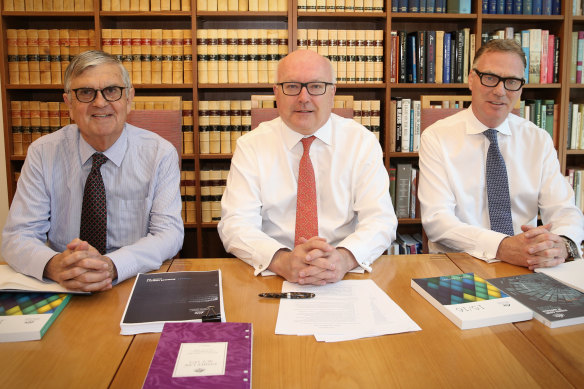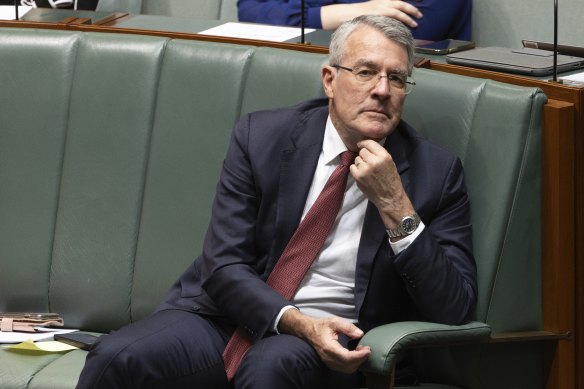This was published 9 months ago
Opinion
Coalition reforms have fixed the family court system. Labor should leave it be
George Brandis
Former high commissioner to the UK and federal attorney-generalOne of the quiet achievements of the Turnbull and Morrison governments was the reform of the family courts.
Family law is always a vexed issue. Because about one in every three marriages ends in divorce, it is the area of the legal system with which Australians are most likely to have experience – either directly, or through a close relative or friend.
While there is nothing that governments can do to eliminate the emotional trauma of family breakdown, they can at least ensure the legal system that deals with it doesn’t make it worse. At the very least, they can ensure the courts are designed to mitigate two of the greatest sources of distress: cost and delay. This was the purpose of a series of structural reforms begun by Malcolm Turnbull’s government, and carried to completion under Scott Morrison’s.

George Brandis, then attorney-general, with (left) John Pascoe and (right) William Alstergren in Canberra on October 12, 2017. Credit: Andrew Meares
The key to the reforms was the restructure of the court system. Previously, two different courts – the Family Court and the Federal Circuit Court – had dealt with family law matters. Obviously, having two different courts administering the same laws led to overlap, jurisdictional confusion and delay. As Chief Justice William Alstergren said in his keynote speech at the No To Violence conference last week: “Four or five years ago, the courts were not in the position they are now to properly meet the needs of Australian families. … [T]he courts were exercising almost identical jurisdiction, but with different rules of court, different case management processes and procedures, conflicting court forms and websites, and sometimes different names for the same basic parts of court administration.”
Through the consolidation of the family law system into a single court – the Federal Circuit and Family Court of Australia – jurisdictional confusion and duplication were eliminated, while delay and cost were significantly reduced.
Structural change alone, however, is never enough. To ensure the benefits of the reforms were achieved required dedicated judicial leadership.
With the upcoming restructure in mind, I recommended to cabinet Alstergren’s appointment as chief judge of the then Federal Circuit Court. Both as president of the Australian Bar Association, and subsequently as chief justice, he has shown himself to be a skilful leader. Importantly, as his principal area of practice had not been family law, he was not part of the self-serving club which had, for years, resisted reform.

Attorney-General Mark Dreyfus has announced a review of the family court system.Credit: Alex Ellinghausen
Alstergren replaced John Pascoe, who became chief justice of the Family Court upon the retirement of the incumbent in 2017. Pascoe, a quietly spoken man who has devoted much of his life to such causes as the elimination of child slavery and improving access to justice for Indigenous Australians, brought immense moral authority to the role. As chief justice, he laid the pathway for reform, often in the face of intense institutional resistance by some judges who were more than comfortable with the status quo.
Another key appointment was the former Labor attorney-general, Robert McClelland. Like Alstergren and Pascoe, McClelland had not been part of the old culture. When I rang then prime minister Tony Abbott to clear the appointment with him – it isn’t often that Liberal AGs appoint former Labor AGs to high judicial office – he warmly embraced the idea. My successor as attorney-general, Christian Porter, who brought the reforms to completion, wisely appointed McClelland as the deputy chief justice of the new court, where the skills he learnt in the NSW branch of the ALP were no doubt helpful in bringing some of the more recalcitrant members of the bench along.
What Alstergren, Pascoe and McClelland shared was personal and professional distance from the old family law club, a willingness to take on those reactionaries for whom reform was a dirty word, and a deep commitment to making the family law system work better for those many Australians who, at the most vulnerable time of their lives, depended upon it. Alstergren has also used his office to pioneer other initiatives, including significant measures to address the issue of family violence, and to make the court a friendlier environment for Indigenous people.
The results of the streamlined new system speak for themselves. Since the new court began, the shocking backlog it inherited of more than 5400 cases, many of which had lingered in the system for years, has been cleared. The number of applications pending a final order has been reduced by 25 per cent, while the number of cases that have been in the system for over four years has fallen by 40 per cent.
Clearing the backlog of cases has reduced the average docket size for judges (that is, the number of cases each judge is allocated) from 330 to just 70. With more judicial time available, contested hearings now come to trial much faster. The time between lodgment and hearing of appeals has been halved. All of this has meant significantly lower costs for the parties. Lower costs mean, of course, lower legal bills.
Last week, Attorney-General Mark Dreyfus announced a review of the Federal Circuit and Family Court. The terms of reference are broad; they are wide enough to include the option of dismantling the reformed system. Many in the legal profession are eager to see that happen. Dreyfus has already shown an alarming willingness to favour the interests of lawyers over their clients, when he reversed the Morrison government’s reforms to class action litigation, to the acclaim of so-called plaintiff law firms. If he succumbs, as well, to the vociferous family lawyers’ lobby, while the lawyers will get richer, distressed Australian families will be much the poorer.
George Brandis is a former high commissioner to the UK, and a former Liberal senator and federal attorney-general. He is now a professor at ANU.